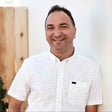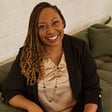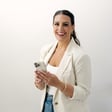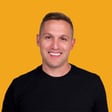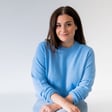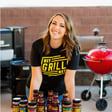Become a Creator today!Start creating today - Share your story with the world!
Start for free
00:00:00
00:00:01

Episode 120: 8 Steps to Building and Marketing your Online Course
Photographer and digital marketer Hope Taylor joins me on the today’s podcast to chat all about building online courses, the most reliable channel for marketing and selling courses, and the tools she uses for all of that. If you've ever been curious about how to build your first digital product this is the episode for you. Hope outlines her step by step process for developing and selling online courses.
For show notes, visit https://daveyandkrista.com/btb-hope-taylor-episode-120/
Transcript
Personal Marketing Approach
00:00:05
Speaker
I have a very personal marketing business. I have a very close audience to me that feels like they know me, and I like to be really actively involved in the launch of a new product. So that can look like a webinar, that can look like a mini course, a masterclass, a challenge of some sort, but I like to do some type of launch.
Episode Introduction
00:00:24
Speaker
Welcome to the Brands at Book Show, where we help creative service-based businesses build their brands and find more clients. I'm your host, Davy Jones.
00:00:35
Speaker
Photographer and digital marketer Hope Taylor joins me on the podcast today to chat all about building online courses, the most reliable channel for marketing and selling courses, and the tools she uses for all of that. If you've ever been curious about how to build your first digital product, this is the episode for you. Hope outlines step by step her process for developing and selling online courses.
00:00:58
Speaker
Be sure to check out the show notes at davianchrista.com for the resources we mentioned during the episode. And we want to hear from you. Let us know what kind of content you'd like to see on the Brancet Book Podcast as we move forward. To leave your feedback, just send us a DM on Instagram at davianchrista. Now, on to the episode.
Hope Taylor Joins the Podcast
00:01:20
Speaker
All right, we should be live. I'm live here with Hope Taylor, a live episode of the Brancet Book Podcast. Hope, welcome to the podcast.
00:01:28
Speaker
Thank you so much for having me. I am super, super excited about this. Yeah, I'm excited that we're able to have this conversation. I was a little bit worried this morning, looking outside, lots of freezing rain, lots of ice. They're saying that expect the power to go out, so hopefully we'll get through the entire episode. I know, fingers crossed, it has been raining for two straight months here in Charleston, it feels like, but we don't have the snow, so hopefully I'll be okay on the power side. Yeah, that's right. We've just had just the worst winter I feel like this year. It's just super wet. It's gross outside. I'm ready for summer.
00:01:57
Speaker
Yeah. All my friends back in Virginia have said that. So, I am just ready for spring. It can come at whatever it's ready. Well, fortunately for you being down in beautiful Charleston, it will hopefully come sooner for you than later. But for those of you who are joining us live, we can answer your questions. So, feel free to drop a comment into Facebook and whenever it fits, I'll try to get that question over to Hope here. And Hope, again, I just appreciate you agreeing to do this live. I know it can be challenging to do this over a podcast.
00:02:24
Speaker
Oh, no, I'm all about it. I love getting questions in real time. It makes it more fun for me. So this is going to be great. Yeah, I agree.
Hope's Business Journey
00:02:30
Speaker
Well, for those of you who do not know Hope, Hope is Hope Taylor of Hope Taylor Photography. But Hope has launched a number of successful courses at this point. And one thing I think she has learned over the course of the last few years is digital marketing. So I'm really excited to hope to jump into more of the digital marketing side of things with you. But I don't want to skip over your story. So for those people who are not familiar with you, could you just tell us a little bit about your background and how you got started?
00:02:54
Speaker
Yeah, absolutely. So my story is a little unique in the fact that I actually started my business as a 16 year old high school student. So I started doing photography as a fun little side hobby when I was a sophomore in high school. My junior year, it started to pick up more. My senior year, I actually essentially went full time. I only went to class until 10 a.m.
00:03:13
Speaker
And then I committed to a university and about three weeks before I was supposed to move into school, I dropped out and went full time instead. So I've been full time for eight years now. First three, four years was just photography. So I was shooting weddings and high school senior portraits. And then I started launching online courses, like what you were mentioning. So now I have.
00:03:31
Speaker
three signature online courses, I teach a high level mastermind to teach digital marketing to other small business owners. And that's the side of it that I actually really love. So this is actually the first time I've taught about digital marketing on a podcast in this way. So it's a topic I'm super pumped to dive into. I'm excited to unpack this a little bit. And I always forget that you started your business so young, you know, and looking back at your kind of your decision to not go the college route and what feelings you have about that? Is that something that you look back and regret at all? Or are you pretty pretty excited about the path you took?
00:04:01
Speaker
Yeah. No, it's just such a fun conversation for me to look back on because I don't regret it at all. I actually, there was maybe one or two times when I was supposed to be at college where my friends would be at a football game and I'd be like, dang, that really stinks. That sounds like fun. But other than that, I don't regret it at all, but it was definitely a transition period because when I decided I didn't want to go to the university I had committed to, my dad actually was not on board with that plan. He was not okay with me not doing college. And so I had to go to community college was the initial agreement. Like, yes, you can
00:04:29
Speaker
live at home. Yes, you can run your business, but you have to go to community college. So I did a semester of community college at the same time as a full time business. So full time course load, full time business. And I was just drowning. So I basically had to sit down and like negotiate with my parents. And I asked for one semester off just to see what I could do if I was just full time business for the first time.
00:04:50
Speaker
And I generated enough income and enough bookings to convince them to not go back and I never went back. So it was definitely, it was a crazy season, but I definitely don't regret it. I'm very grateful for the path I took.
00:05:02
Speaker
Yeah, that's amazing. Chris and I, it's funny with having Jack, our two-year-old, talking about college and planning for college. Chris and I both went to college, but we kind of look back on it and be like, does it really necessarily anymore? But anyways, not to get sidetracked with that too much.
Transitioning to Online Business
00:05:16
Speaker
I want to talk about just the transition from running a service-based business into building more of an online business.
00:05:23
Speaker
I think it goes without saying that you built this successful photography business. You still have a successful photography business, so that's still up and running. But what were the biggest challenges in getting into running an online business?
00:05:36
Speaker
Yeah, honestly, there were so many challenges because I started this when I was 18 or 19. So I was just so deep in the service-based side of business that I was clueless on the digital marketing side, right? Like I went into this completely blind. And I think that I had like three big struggles that I wanted to touch on because the first biggest struggle, which this is going to sound kind of fluffy and I don't want it to, but
00:05:56
Speaker
I overcomplicated every single piece of it. And that's still to this day. One of the things I teach every single one of my like high level coaching students is to stop trying to overcomplicate it. I think a lot of people look at what other leading people in the digital marketing space are doing and they assume that it's way more complicated than it is. And it looks more complicated than it is. Right. Like it looks impressive, but it doesn't have to be complicated. So that was the biggest challenge I faced as I was trying to do way too much and way overcomplicate the processes and that side of my business.
00:06:26
Speaker
So that's a big thing. Second thing is I kind of rushed into it. I expected online courses and digital products to be just like quick and easy money if I'm being super candid. I just looked at it and I was like, I see so many people high up in the digital marketing space making millions on course launches. This can't be that hard, right? Like that was my 18 year old very ignorant assumption.
00:06:45
Speaker
And I was very wrong. I totally like just went into it way too fast with way too high of expectations. And I also, third thing, heavily underestimated the power of email marketing. I like jumped the gun, put the cart before the horse and didn't prioritize that before I started the course creation process and the digital product creation process. And so you're learning from somebody today who did it wrong at the beginning and has now learned the right way to do things. But those were definitely the three biggest challenges that I had back then.
00:07:14
Speaker
Yeah, I'm excited to dive into a little bit more about those three things, especially email marketing. I know you have a lot to say about email marketing specifically. What are some of the areas that you overcomplicated in the beginning that maybe you wish you could go back and just kind of focus on instead of the areas that you overcomplicated stuff? And I do chuckle just when you say, you know, in terms of rushing into it and maybe anticipating it to be easier than it actually was. And I think I hear about that. I hear that often from people and people that I help as well that
00:07:40
Speaker
It's like, I'm going to launch this course and it's going to make thousands or tens of thousands or hundreds of thousands right out of the gate. I think a lot of people fail to realize it's starting another business. Even if you have a successful service-based business, when you start launching digital products, you're virtually starting another business. All that effort you put into creating that first business, expect to put that same effort into that second business as well. What are those areas that you wish you could go back and simplify?
Creating Effective Online Courses
00:08:04
Speaker
Yeah. I think the two biggest ones were one determining what my offers were and what my audience actually wanted from me. I think that looking back, I was just ready to launch like 10 different things. I was like, I have 10 different ideas. I'm going to do them all. But I realized that the best thing that you can do, which I'm going to talk about more in a little bit is to just really dive deep and spend a lot of time determining what your audience actually wants from you, because it'll probably surprise you that it might be different than what you think it is. And also it's better to just launch one really, really strong product than 10 not as powerful.
00:08:34
Speaker
So I overcomplicated that whole process. And the second thing is just my entire email marketing workflow. Like I overcomplicated it to the point that I paralyzed myself. I just did not know where to start because it all seemed so overwhelming to me. And now my funnels are so simple that I think that when we talk about them today, some people are going to be like, wow, I can actually do that. Like that makes sense. And it's easy to do.
00:08:55
Speaker
And I overcomplicated segmenting and just wanting to tag my list out to have all of these customized funnels. And in reality, it doesn't have to be that hard. So I paralyzed myself with options and got overwhelmed. And now it's just, it's so simple, but it's kind of ridiculous.
00:09:09
Speaker
Yeah, awesome. And so, excited to chat, offer building with you as well. Because I'm a big believer that people don't buy products, they buy offers. And so, really crafting the right offer is going to be crucial for people actually buying your course or your digital product. Real quick, just so people have some context, what are the different courses that you sell?
00:09:26
Speaker
Yeah, so senior portrait photography has kind of always been my niche within the photography industry. So all three of my signature courses are about senior portrait photography. So the first one and most popular is called the senior business course. It essentially runs through how to start market and run a successful senior portrait business. I also have a spokesmodel course, which is also senior photography related, teaches people how to build a successful spokesmodel program. And then my third one is just my photography course of shooting, lighting and editing.
00:09:54
Speaker
Okay, awesome. So moving to the conversation of starting to build passive income channels, where exactly should people start? Yeah, I have a three step process for this too. And the first step is completely vital. And like I mentioned, it's one that I essentially completely skipped over and still don't think I utilize enough to this day. And that is to just pull your people, learn your audience, learn your customers, learn what they're wanting from you. Don't just assume that you know what people want.
00:10:23
Speaker
because when I was starting my digital marketing business, my education side of my business a few years ago, I thought people wanted to learn senior photography for me initially. I was like, that's what they want to learn. Everybody wants to learn how to shoot, how to go to a session and have a good time, how to rock out your client experience, all that stuff. But when I actually polled my audience, people wanted to learn about my spokesmodel teams first. That was the most popular question I got. It was totally different than what I was planning on teaching, but I didn't think to ask. I was just like, I know this is what people want to learn, but
00:10:52
Speaker
I was very wrong. And so I recommend polling your people and that can be done in a lot of different ways, even just on Instagram stories. And you can also survey your audience, like send a survey to your email list or post it in your Facebook community or just share it with your audience with some type of incentive and ask really specific questions too. Like don't just say,
00:11:12
Speaker
What do you want to learn from me? Ask what type of photography they do, how long they've been in business, what their biggest pain points are, what they feel like they're really good at in their business. Really learn who your audience is so that you can understand how to serve them better. Because if you create a stellar online course, but nobody was asking for it and nobody wanted it, it's not going to sell. So you need to be sure that you know your audience and you know what they want.
00:11:33
Speaker
Absolutely. I assume that how much do you take those whole questions that you ask and then work that language into something like a sales page or your lead magnet landing page or whatnot?
Course Content Development
00:11:44
Speaker
Oh, so often. I actually do this process each time I start the process of creating a new course. I send a survey out to my audience and I give a Starbucks gift card as an incentive. I'll randomly give somebody a $50 Starbucks card.
00:11:55
Speaker
That gets you way more responses. But I do this at the start of every course creation process specific to what I'm going to be teaching on. And I will take those exact questions that people ask and put them on my sales page and address them in the course. And I even say that the questions addressed in the course are from real photographers all over the world. I really emphasize the fact that I'm taking the time to learn my audience and teach them directly.
00:12:16
Speaker
Yeah, awesome. And I talk to so many people, especially on the website design side of things, where they're like, I don't even know where to start with my sales page. Well, this is where you start. You're literally getting answers to your questions from people who are interested in taking a course that you've designed. So, I guess what are the steps? Starting there, polling your audience. What are the steps in building a successful online course?
00:12:37
Speaker
Yeah, so I could talk about this for hours and I told you I have eight different things I want to walk through. So I'll go through one by one and we can kind of address each thing as we go. But like I said, step number one is going to be to poll your people. You want to make sure that you're getting to know your audience, you're getting to know what they want, and you're really understanding exactly what they're looking for from you.
00:12:55
Speaker
And you also want to start kind of outlining the course as you get that feedback. So I, when I'm outlining a course or an offering, I literally just brain dump into a Google document. I don't have a cute or pretty process for this, but once I start getting those survey responses, I just start brain dumping everything people are asking me into a Google document.
00:13:13
Speaker
And I start breaking it up into modules like, okay, these are the overarching topics people need to learn. Here's the chronological order I think will be the most valuable. And then I break up lessons within those modules. So basically just the survey and brain dump process needs to come first. And this is a few month process for me.
00:13:29
Speaker
I take quite a bit of time to really sift through this outline and I show it to people. I get feedback from existing students. I get feedback from people outside the industry and I just make sure that I'm filling any gaps in creating an all-inclusive resource based on the feedback I'm getting of what people need from me. Yeah. I like how you ask people outside of the industry as well. What's your primary purpose of asking people outside the industry?
00:13:50
Speaker
I think that sometimes one of the hardest things as an educator is to think back to the questions that you would have had if you were brand new. I really struggle with this. I'm like, okay, 10 years ago, what did I not know about photography? And it's really hard to figure that out because now I've been doing it for 10 years. I know pretty much everything there is to know. So I will show my mom, I will show my boyfriend, I will show people who have no idea what I'm talking about.
00:14:10
Speaker
and I'll let them ask me questions to find the gaps of like, okay, if somebody's brand new to this, they wouldn't know the answer to that, but I wouldn't think to teach it because I'm so close to the content. So it actually really helps you to find the gaps in what you're teaching.
00:14:22
Speaker
Yeah, I think that's really wise to do. And I think I've even found in different even blog posts that I've written, you know, they're based on questions that people asked and how I never asked, I would have been like, I just assume, oh, everybody knows this, why would I write this blog post? Or why would I create this course? Why would I create this product? You know, so I think that's a really interesting tip to go outside of the industry. Anyways, what's step two?
00:14:41
Speaker
Yeah, so step number two for me is to start building out my content. And for me, I think some people would be like, hope you're putting the cart before the horse a little bit because I just go straight from this brain dump outline to a keynote or a PowerPoint where I start building out my content. It's helpful for me to visualize everything.
00:14:57
Speaker
lesson by lesson and I start breaking down the actual slides that I'm going to teach in the course. That's just the process of building the content for me. So I go straight from an outline to a keynote and I start breaking down the lessons, the content, the notes. I'm typing out everything as I go. Again, this is a couple month process for me, but this is where I actually am going to be building out the content that I'm teaching.
00:15:17
Speaker
Awesome. As far as the content that you teach, is it a mixture of slides and screen share and you on camera or is it mostly slides? I guess when people are building a course, what should they expect to invest in terms of the actual creation of the content?
00:15:33
Speaker
Yeah. So this is the perfect segue to step three, because that's when I began to film the course. I am somebody who is a huge believer in production quality. There would be courses and digital marketers that would tell you that it's more than enough to just sit and do some voiceovers of some slides. I think that that serves its purpose and that that can be done really well. But I run a very personal business. My marketing is very personal. My audience really feels like they know me. So if I were to market that way on the front end of my business and then sell a course where you can't even see my face,
00:16:02
Speaker
audience would be very disappointed. There'd be a major disconnect there. So for me, filming my courses is a very big investment and I do all of my videos of me speaking directly to the camera as well as a combination of live action shooting for me because I'm photography specific. So every single video is me talking to the camera. We insert the slides into those videos, but they are live action, me talking, teaching, and literally doing what I'm teaching about.
00:16:26
Speaker
So I invest in a really high production quality. I don't necessarily think the extent that I go is necessary. I'm just crazy about that kind of stuff. But I do believe that at minimum there should be at least a welcome video and an outro video where you are talking to the camera and showing your face. Your audience needs to be able to connect with you.
00:16:42
Speaker
I like that. So welcome and outro at the very least and then what you can invest into production quality. And I think for a course like yours, especially when teaching about something like photography, it's really helpful for people to actually see subjects and you interacting with people. So I assume that's probably pretty important. I teach about SEO often.
00:16:59
Speaker
So probably less about my face and more about you know the screen people want to know settings and stuff like that but agree I think that you know video it just in general you know I mean it's funny like even when I started the podcast I didn't have this mic and this mic is way fancier than the one I initially started with but people brought that up you know like when you first oh yeah you know I wish you'd have a different mic you know so I just didn't think it would matter all that much so definitely I think that people noticed so what's step four?
00:17:26
Speaker
Yeah. Yeah. So step four is kind of an optional step. It's something that I have always really, really loved doing. And it helps me in my kind of
Beta Testing and Feedback
00:17:33
Speaker
launch process. And that is to beta test the course or what I call beta testing my course. So what I do is once we filmed the entire course, I start working on this process of collecting what I call beta testers. And these are essentially photographers that are my ideal student, somebody who I look at and I'm like, that is the ideal customer, exactly what I'm looking for. And I want their feedback. So I actually do an application process for this.
00:17:56
Speaker
and I have existing students in my Facebook community. So I only give them access to this application. I don't open it up to the public, but they can apply. They tell me a little bit about their business, a little bit about their struggles, and I determine who is the best fit to be a beta tester. I like to pick 10 to 15 people. And then once the course is ready to go, I give them free access to the course in exchange for this little laundry list of to-dos. And so they have to complete a survey and give me feedback, and they kind of become a part of my launch team.
00:18:26
Speaker
So they help me to promote the course when it does go live. They help me to promote whatever my launch catalyst is going to be, which we'll talk about in a bit. And they kind of become like my cheerleading squad for this new course. But in addition to that, they give me all of the feedback that I need to be sure that it's a well-rounded course, that there's no technical things wrong that I missed.
00:18:44
Speaker
the biggest piece is that they give me social proof. They give me a ton of positive feedback, testimonials, and I actually teach them when they sign up to be a beta tester how to like post in the Facebook group with their wins as they go through the course, how to share on Instagram stories. And I screenshot all of that stuff and it comes back to my sales page and becomes the most powerful social proof you could ask for because you're kind of directing
00:19:07
Speaker
them on how to give you the feedback that you need, both in a very positive way to promote the course, but also to make sure that the course is good to go and 100% ready to be launched. That is actually solid. As far as the, and forgive me if you mentioned this, but do they get anything for being beta testers? Do they get the course for free? Do you usually make a smaller fee? What's that look like?
00:19:27
Speaker
They get the course for free, so I make it a very exclusive. I build up tons of barriers to entry. I make it a really exciting process, so they get the course for free, but I want them to be so excited about it that it's a natural thing for them to help me promote it and share about it. So I create this really exciting, exclusive environment for them, and they do get that course for free.
00:19:46
Speaker
Yeah. And I think that's just such a valuable process to go through is actually collecting feedback from real students and just, you know, we all make mistakes putting stuff together. So it's really helpful for somebody to be like, hey, you definitely did this video, you know, you won or whatever. So definitely helpful in that front. So what's the next step?
00:20:03
Speaker
Yeah. So next step is going to be to choose your launch strategy. So launching to me is like a whole different ballgame. We could talk about that for hours and hours, but I like doing a live launch. So some people will just do like an email marketing launch where they just send emails to their list that the course is available. I think that's great. But for me, like I mentioned, I have a very personal
Launch Strategies
00:20:22
Speaker
marketing business. I have a very close audience to me that feels like they know me. And I like to be really actively involved in the launch of a new product. So that's
00:20:29
Speaker
That can look like a webinar, that can look like a mini course, a master class, a challenge of some sort, but I like to do some type of launch. And so I recently have started doing five day mini courses, which is essentially like a five day webinar, but it's like a five to 10 minute video per day. And that on the third day, they get access to the new course. So it's kind of this just exciting launch week. It's a little taste of what the course content is going to be and they get exclusive first access to the course.
00:20:56
Speaker
It's this live, really interactive launch that helps me to make way more than if I were to just send it over email. Yeah. So in question about the five-day mini course in particular, and so I think this applies just to the pre-launch, whether you're doing a webinar, five-day mini course, or you can send the emails out. How do you balance the content that you share versus the content that's behind the paywall, that content that people actually have to pay for? I think one thing that I can hear from people is like, well, I'm worried about giving away too much before they actually purchase the course.
00:21:25
Speaker
Right. So I have kind of a two sided answer to this. Short answer is that when I'm teaching free content, I'm typically teaching the what and the why, but not necessarily the how. So I'm talking through like, here's what I do in my business and here's why I do it in order to learn the step by step and get the templates and the photos and like the behind the scenes videos you have to buy the course.
00:21:44
Speaker
But I also believe that the value of the free content that you give is powerful. It's kind of like your first impression, right? Like you want to make a stellar first impression on these people that are going through this mini course or this webinar or this masterclass. So if there's a little bit of overlap in your free content and your paid content,
00:22:02
Speaker
That's okay. It does not have to be completely different. It's okay if it's a little bit of overlap because of being better for your free content to be really powerful and for them to think, oh my gosh, if this is free, I can't imagine how good the paid stuff is. It's better for it to be really powerful than really weak because you won't make a sale if your free content isn't transformative in people's businesses.
00:22:22
Speaker
Yeah, and I have to imagine just having heard you teach before that you don't have, there's so much that you could teach. You're probably figuring out how you can whittle your courses down versus, you know, oh, no, I don't have enough content or something like that. And that's typically what I tell people after there, you know, as they go through the course process is like,
00:22:38
Speaker
There is so much in it. Even I get our webinar on, let's say, something like SEO. I mean, there is just so much more than that. But I think what your distinction, though, between teaching the what and why and then saving the how for the course makes a lot of sense. And I think people feel like they probably still get a lot of content from that because it's really helpful to know what people are doing in their businesses and probably get them then excited though, oh, how does she do that? How can I implement it? I really think that distinction is helpful.
00:23:07
Speaker
Yeah, and a great example of this is my spokesmodel mini course that I do to launch my spokesmodel course.
00:23:12
Speaker
I basically teach them it's a challenge, so by the end of the five days, they can launch a spokesmodel application to get people on the door. But then in order to know how to run the spokesmodel program, how to maintain it, and how to do it strategically, you have to get inside the course. So I teach them what to do, and I teach them why I do it, and I help them to launch an application. But then in order to learn how I maintain it throughout the whole year of the program, they have to take the course. So that's a really good example of the what and the why, but you have to pay for the how. But it's still so valuable. It's still so helpful to people.
00:23:40
Speaker
Yeah, absolutely. So I think we're on step six. Yeah. So next step is to get your audience really, really excited. And this is something that I love about launching. But I think that the biggest thing people do wrong when leading up to the launch of a new product is that they feel like they're being annoying. They feel like a broken record. They feel like they're talking about it too much. So they hold back from sharing.
00:24:01
Speaker
on their platforms and with their audience because they're like, I don't want to annoy people. What if somebody unfollows me? What if somebody unsubscribes from my email list? But I love the statistic of if somebody has to see something seven times in order to even like know it exists or opt into it or interact with it. And I would say that number is even higher now with how fast piece the digital marketing world is. I think it's like 10 or 12 times.
00:24:21
Speaker
So when you think about that, one of your followers needs to see you mention your course 10 to 12 times in order to even fully process that it exists. And so when you think about it like that, you have to talk about it all the time. Like you have to be excited about your course. You have to talk about it like you're excited about it.
00:24:37
Speaker
And the more barriers of entry you can put up, the more exclusive you can make it feel. I call it the art of FOMO, the art of the fear of missing out. If you can make people feel like they're just missing out on this exciting opportunity by not opting in, then that's the best way to go from a marketing standpoint. So I'm sharing tons of social proof. I'm using language like
00:24:55
Speaker
Hundreds of photographers from all over the world have already signed up. Dozens of people are already inside this course. I'm showing a back-end peak of screen recordings of the Facebook community and people interacting there. I'm just constantly putting up these barriers of like, well, you're not in the Facebook group, so you're missing out on the fun, or you're not in the course, so you're missing out on this content. You want to share about it so consistently that you feel annoying, but that you know that your followers can't help but see it. They can't avoid it, no matter how hard they try.
00:25:19
Speaker
Yeah. And you combine that number that you gave, whether it's seven or now higher, because the amount of marketing messages that we receive in a day, which is sort of insane, the percentage of people that ever see your organic posts to begin
Promotion and Audience Engagement
00:25:28
Speaker
with. So with organic Facebook now, it's like nothing. Organic Instagram even, such a small percentage of the overall followers. So you can kind of count on only 10 out of every 100 people having seen a given post or something like that. So there's definitely reason to continue to share about it. But then also, I think
00:25:45
Speaker
you're there to serve those people, right? I mean, those are the people that are interested in what you're doing and what you're teaching, you know? So, don't worry about the rest. And I've never sent an email that somebody hasn't unsubscribed from. So, it's just not possible. But I know if you're just starting an email list, of course, like every single person feels like, oh, I don't want them to leave, you know? It is just a reality of email marketing, I think.
00:26:08
Speaker
It is. And I love that quote too, if you're marketing to everybody, you're reaching nobody. So it's okay if you turn some people away. Totally okay for people to unsubscribe, totally okay for people to unfollow because they probably weren't going to pay for you anyway or pay for your product or buy your service. And so they're not an ideal customer. They don't need to be there. So those numbers, some people leaving is a good thing. Yeah, absolutely. So what is step seven?
00:26:29
Speaker
Yeah. So step seven is going to be your actual launch. So leading up to this, we've been kind of planning what our launch catalyst was going to be. We've been getting our audience excited, giving them sneak peeks into what's coming. And then we're actively launching. And like I said, the launch could be a whole different conversation, but basically what I do is I have one week that's dedicated to launching to whoever is in that launch catalyst, whoever's in that webinar, that masterclass, that mini course, one full week is dedicated to just them. So they're getting access to the course before anybody else. I want that.
00:26:56
Speaker
to feel exclusive. I want that to be a barrier that's put up. I want them to feel like they're this exciting kind of community that's getting first access. And then the following week is my public facing launch. So that's when I launched to my mailing list. That's when I launched to my social media platforms. And that is when everyone else is getting access to the course.
00:27:13
Speaker
I like to do a first-time launch price. This is something that you can kind of take or leave. But during the very first launch of a new course or product, I will do the lowest price that I'll ever do. And I call that the launch price. And I market the crap out of that. That's kind of my exclusive offer during the week of a very first launch is I offer the lowest price that it'll ever be. Yeah, awesome. And just as an extra bonus or incentive for people to sign up, I'm guessing.
00:27:37
Speaker
Right. Absolutely. I want there to be that scarcity and I want there to be that exclusivity. And so, I try to make sure that it's really hit on the fact that the discount is going to expire and that this is the lowest price they can get. Yeah. And just out of curiosity too, I know there's a lot of different ways to do this. Open cart, closed cart, evergreen, some sort of hybrid model. How do you run your courses? Are they evergreen? Are they all live launches? What does that look like for you?
00:27:59
Speaker
Yeah, this is awesome because step number eight is to automate. So I have kind of a hybrid model right here where I have my courses are evergreen. They're always available, but they're available at a slightly higher price than they would be if you could find it in a funnel or during a live sale. So basically, for example, my most popular senior course is available for $600 all the time. You can buy it on my website literally whenever you want for $600.
00:28:23
Speaker
If you get into one of my automated email funnels, I offer a deadline funnel, which means it's a short term discount for 48 hours for 457. So you can buy the course inside of one of my funnels for 457. So it's kind of that hybrid model of there is that urgency, there is that deadline funnel, but you can still buy the course at a higher price whenever you want to. Yeah, awesome. Do you feel like automation is something that people should I guess, how long should you do the live launch before getting into automation?
00:28:52
Speaker
Yeah, so I do both. So I do four live launches throughout the year, as well as those automated email funnels. I think that the best time to automate is after your first successful launch. And by successful launch, I mean hitting your goals, converting at standard conversions, all of that good stuff. I think until you make sure that your course is well-rounded and is kind of finished, which for me, I've refilmed a couple of my courses still. Like I'm always adding to them. I'm always upgrading the content, all of that good stuff.
00:29:19
Speaker
Once you have that down to kind of a science and you're really confident in your course, that's when I would automate. For some people, that's after their first launch and that's awesome. For some people, that's going to take three or four launches to get to the point where you're really confident in the content inside the course and the structure of it and all of that stuff. And then I would go ahead and automate.
00:29:35
Speaker
Yeah, I think that's good advice. I think making sure you're paying attention to standard conversion rates too. Even if your live launches can be a little bit higher than your standard conversion rates, just because when you do move something evergreen, people typically know when it's evergreen. You actually see, at least for a webinar style launch, slightly lower conversion rates than what you would see for live launches usually. You want to give yourself a little buffer there. Those are the eight steps. I think that's super practical.
00:30:02
Speaker
I have a whole page full of notes, so I'm trying to figure out where else I'm going to fit my notes here.
Tools for Success
00:30:07
Speaker
But I want to talk a little bit about the tools that you use as well because I think that's kind of logical next question is, okay, so you do all this stuff. What are your favorite tools for doing these things? And I don't know if we want to go over those in any particular order. You had mentioned, for instance, deadline funnels. I definitely want to ask about what you use for email marketing. You do for live webinars and things like that. So I'll just let you start with what you want to talk about.
00:30:31
Speaker
Yeah, so we'll talk about email marketing first because I think that this is the first priority step for anybody that's wanting to break into passive income at all. And before those eight steps that we just talked about, email marketing needs to come first. You need to have an existing email list and an existing lead magnet to be getting people on that list before those eight steps can even begin.
00:30:51
Speaker
Number one priority for anybody listening that is brand new to this concept, start an email list like yesterday and start building that list. So for email marketing, I use ConvertKit. For me, I found that it's the perfect balance between like MailChimp is a little bit too simplified for the automations I need. And then something like Infusionsoft is just unnecessarily complicated for me. I've found ConvertKit is the perfect middle ground, it's user friendly, and it does everything that I need it to do.
00:31:17
Speaker
Yeah, and they have a free plan now, which is awesome. So for anybody, I feel like so many people went with MailChimp to start because they had the free plan. So now there's really no excuse not to get started with something like ConvertKit. Yes, I absolutely love it. And then for my course platform, I use Kajabi. So for a while, I used Thinkavic because Kajabi was a little bit pricier. But now my advice to all my students is to do as I say, not as I do, I ended up needing to move
00:31:41
Speaker
500 plus students from thinkific to kajabi and it was a pain like moving all of my courses from one platform to another is not fun and kajabi now serves the purpose that click funnels was used like i used to have to use click funnels to link convert kit with thinkific and now kajabi does that for me so it basically does what a bajillion different programs can do but in one place so i love kajabi i think it's crazy valuable
00:32:03
Speaker
We did the exact same thing. We started with Thinkific, moved to Kajabi. Kajabi has been so much better. Also just a cleaner user experience I feel like for students or members of your program. But man, what a pain to switch.
00:32:18
Speaker
I mean, and that's true of email list too, I think. That's why it's great to start with something like ConvertKit because you can really grow into it. That's funny that you said that. As far as the features of Kajabi that you use, because Kajabi you could use as an emailing list. We actually do the exact thing you do. We use ConvertKit for our mailing list. One of the features you use of Kajabi, what do you not, especially as it regards to the webinar platform?
00:32:43
Speaker
Yeah, so I haven't tried the webinar platform yet. I actually haven't done any live webinars in like two or three years. I've been using that five-day class structure instead. I found that webinars were really oversaturated to my audience and they started to like expect a pitch, sign off early, not show up live, all that good stuff. So kind of switched the gears there. So haven't tried the webinar feature.
00:33:02
Speaker
pretty much only use it right now for my online courses, including those five-day free mini courses. So what I love about it is it can host those for free, and it does the slow drip feature that ClickFunnels was doing for me before, and it's just a way better user experience for the students that are doing that free live launch. And so I really loved it for those reasons. I haven't played with the email marketing feature. I've heard it's a little bit more complicated than ConvertKit, so I think I'll just stick with ConvertKit. But right now, I'm primarily using it just for my courses and then those free five-day challenges.
00:33:31
Speaker
Okay, awesome. The five-day class, that's all done through ConvertKit. You also mentioned using deadline funnels. Could you give us a little rundown on what deadline funnels is and why you use it? Yeah, so deadline funnels essentially creates a custom deadline for each individual person that goes through your email funnel. What happens is if Sally joined your mailing list today and goes through a five-day sales funnel for your course, then it's going to give her a custom deadline link so that after 48 hours, her link to get the course for a sale price expires.
00:34:01
Speaker
So it does that for each individual person. It creates a custom deadline for each person so that within the sale window, they have a custom link where they can get the course at a sale price. And then after the sale expires, it expires that link. So it's a true deadline. It's a true sale ending because there's really no other way to do that without having to actively be changing the links for each person that goes through.
00:34:20
Speaker
Yeah, for sure. And I haven't found anything that is even comparable to deadline funnels just in terms of functionality, just the power behind it. I mean, there's definitely different tools that you can add that will give you a countdown timer, let's say, or redirect people once the offer is over. But deadline funnels really seems to be the only game in town if you want something that's going to truly customize a deadline for individuals that are going through your funnel. And fortunately, pretty easy to set up, great customer support.
00:34:48
Speaker
Sounds complicated, but I think maybe easier than people expect.
00:34:51
Speaker
Yeah, I was shocked at how easy it was to set up. Honestly, I thought it was going to be crazy complicated and I didn't have a hard time with it at all. So definitely highly recommend it. And then the two other programs I wanted to mention my website platform is show it. The reason I love show it is that you can have an unlimited number of what's called plus sites. So I can have all of these different sales pages and quarterly sales pages and thank you pages and things that I customize and show it that are really aesthetic or really match my brand, which is something that I value highly.
00:35:19
Speaker
and that I can use in all of those funnels and all of those emails and to sell off my courses. So love show it. And then only other program I use, which might not be as relevant to digital marketing is I use RegFox as a program to get in-person workshop registrations and registrations for things like my mastermind. That can be hosted in Kajabi too, but I just thought it was worth mentioning because I typically get that question about how I sell in-person workshop seats.
00:35:41
Speaker
Yeah, great. And show it's a great platform for big show fans as well. And the great thing about show it is you can easily make your sales pages and landing pages and show it. It works well with something like a job. So I think that's a great stack. Anything else, any other tools that you wanted to mention?
00:35:57
Speaker
No, not really. Those are my big digital marketing tools. Only other random tool that I use is Sticky's, which is a free app on my desktop. And it's how I keep track of my outlines and my brain dumps for everything in my business. And I always mention that because my entire desktop is just little sticky notes that have brain dumps on them that make no sense to anybody else, but it's literally how I run my entire business. So that's the only other thing I use to keep my life together. You stress me out looking at your desktop. Yes, it stresses a lot of people out, but it makes sense to me.
00:36:26
Speaker
Sure. Sure. And that's the important thing. Awesome. So as far as marketing your online business, what is the most effective channel for marketing your online products?
Email Marketing Importance
00:36:35
Speaker
So I sound like a broken record. I think everybody knows I'm going to say email marketing is the number one way to go. I, like I said earlier, completely disregarded the power of email marketing leading up to a course launch. I have always had a large Instagram following. That's always been my number one social media platform. And so I just assumed like, Oh, I have 40,000 people that follow me there. And so it's going to be super easy to just sell this course to 40,000 people. But that is not how it works because like we talked about earlier,
00:37:00
Speaker
nobody's organically saying your post anymore. You have to talk about something like seven to 10 times in order for people to even see it. And it's just really hard to take somebody who would be considered technically a cold audience member because they're not on your email list to being a buyer. You kind of have to slowly warm them up to the idea of buying from you. And you also have to earn their trust. That's kind of one of the steps of the process I didn't really think about. I was just ignorant to the fact that just because they follow me on Instagram doesn't mean they trust my expertise. There needs to be a bridge there that bridges that gap between,
00:37:29
Speaker
Oh, she has cute outfits. So I'm going to follow her on Instagram to like, Oh, she knows what she's talking about. I'm going to pay her a few hundred dollars. So I'm bridging that gap. Email marketing is the best way to do that. So essentially my number one goal with anybody that interacts with me online is to get them on my mailing list. So
00:37:45
Speaker
We can talk a little bit about that if you want to, but basically I think one of the best things you can do is just have one lead magnet, so one free piece of content that people can download from you. That could be an ebook, that could be a video, that could be a PDF, it could be whatever you want it to be. But I recommend just having one main signature opt-in that you point everybody to, and that you talk about on social media, that lives in your Instagram bio link, that lives on the homepage of your website, that lives on your blog, that lives everywhere.
00:38:12
Speaker
So, you're kind of collecting as many emails as you possibly can, no matter where they're interacting with you. Yeah. I agree with everything you're saying about email marketing. I think people are surprised to hear, oh yeah, I have this huge Instagram following, but that's not actually going to convert in the same way. One of the great things about email marketing is that it just converts in such a consistent way. You can say, okay, for a new launch with a smaller email list, you can expect maybe 8% to 12% of people
00:38:35
Speaker
on your email list to convert. And then of course, as the list gets bigger, those conversion rates typically go down a little bit and you can expect somewhere in the ballpark, maybe 3%. But you know that, right? It's kind of like there's this almost science behind it. Whereas with Instagram accounts, not as easy to understand different conversion rates or
00:38:51
Speaker
There's a lot of variability too between somebody might have 120,000 Instagram followers, but only have 100 people at a time engaging with their posts. So a little bit more challenging. One of the things I think also helps you bridge the trust gap so quickly is that you have this great combination of sending people emails, but then also using video as well in your email.
00:39:10
Speaker
and having people connect with you face to face. I think that probably helps bridge the trust gap so much more quickly. I would like to ask, I think having a single opt-in advice is great advice too. People think, oh, I got to have 20 different opt-ins and it's so time consuming, it's hard to push all of them well. I think focusing on single opt-in is great advice. What are other effective ways to build your mailing list through these opt-ins?
00:39:33
Speaker
Yeah, so one of the ways that I do this and one of the most important things I think in earning your audience is trust. And one of those things that I think needs to come before a course too is you consistently adding value to your audience at least once a week, every week in some capacity. So I have this essentially on automated workflow. I do one YouTube video each week and that YouTube video goes on my blog. It gets sent out to my email list. It gets shared about on all my social media platforms. I call that my pillar piece of content each week. It's like,
00:40:00
Speaker
The main piece of content that I share with my audience every week and the goal with that is just to add value to my audience. I don't care what the topic is. I don't care what I'm talking about. I could just take an Instagram question. Somebody asked me in a DM and turn it into a YouTube video, but I'm just doing my absolute best to consistently show up and add value to my audience in some way every single week.
00:40:19
Speaker
The more you can automate that process and have a workflow for kind of like bulk creating that content, the better. But each time I'm creating one of those videos, I'm sharing it across all of my platforms and I'm pointing back to that lead magnet that I was mentioning. So short answer, YouTube is a great way to build your audience organically. It puts you in front of people that otherwise wouldn't find you. And it's a great way to just add value by answering people's questions.
00:40:40
Speaker
Instagram is another great one, but when it comes to Instagram, obviously the algorithms are a little bit tough right now. And so I think the best way to interact and build an audience and build your mailing list on Instagram is actually to just interact with people and use Instagram to be social. Like show up on your stories, comment on people's pictures, reply to DMs, focus on building relationships with individual people, not with just trying to like speak out into the masses.
00:41:05
Speaker
Yeah. And I think, again, another for people listening, I think one thing you do really well is you're pushing that. It's like going back to that comment you made about, you know, being scared about being annoying, but really kind of push it everywhere, you know? And just assume that people haven't heard it before. And I mean, that is the great thing about email and followers. And if somebody truly is not engaged or not interested, they'll unsubscribe and that's okay too. Right. Absolutely. Because they probably weren't going to purchase.
00:41:28
Speaker
Yeah, I think the advice of having some sort of pillar content, making the most out of the content, sharing it across different channels and always pointing back to that lead magnet, super
Building and Engaging Audience
00:41:35
Speaker
effective. Is there anything else that you do to grow your email list that is worth talking about?
00:41:39
Speaker
Yes. I do Facebook ads. That is something that's been new in my business in the last two years. So I organically built my email list to about 10,000 without Facebook ads. So the thing I don't want people to think if they're listening is like, Oh, I'm just starting a Facebook ads is the only answer. There's totally ways to organically build your audience without the need for paid ads. But I did start doing Facebook ads about two years ago and now kind of had the entire process on autopilot. So I'm running ads for a lead magnet that directly correlates to each of the three courses and gets people into an email funnel from there.
00:42:09
Speaker
Yeah, awesome. I would say that even from a course launch perspective, it can be pretty much just as effective to run Facebook ads straight to your lead magnets and getting people into that funnel that converts really well. Even more so, I think, than running ads straight to the course. There's definitely a time and place for that. Totally. One of the things that we're always encouraging people to do is really focus on building that email list because that is going to be one of the most predictable areas where you understand what's going to convert, what's not going to convert.
00:42:35
Speaker
Well, and you own those emails, right? Jenna Kutcher said this one time, if Instagram were to disappear tomorrow, how would you engage and interact with your audience if it just disappeared? And it was a terrifying thought to me because I didn't have an email list when I heard that for the first time. And so one of the greatest things about email lists too is nobody can take those emails from you. There's not an algorithm working against you. Like you're going to show up in people's inbox and you know that you can rely on that. And I think that that is one of the things like you're saying that just makes it so valuable.
00:43:00
Speaker
Yeah, absolutely. Well, this has been such a great conversation. I really appreciate you taking the time to join us and share not only steps to building a online course or getting started with your first digital product, but then also just talking about some lead gen stuff, which I'm glad you brought up one of the most important aspects of building an online business, I think even more so than a service-based business where we're all doing lead gen, but maybe we don't realize it because we can only serve 20 people in a year.
00:43:27
Speaker
people in a year. It's all of a sudden having a list of 10,000 people doesn't matter as much. But when you're selling a product that can scale, having a list does matter. The lead gen does matter. So I'm glad you brought all that stuff up. I am sure there's people following along here that know you from all your courses. Your courses are still available. So if you're looking to get into senior photography, especially definitely check out Hope's courses. But Hope, for people who want to learn a little bit more digital marketing from you and how to build passive income in their business, where should they fall along? Where should they connect with you?
00:43:56
Speaker
Yeah, Instagram and YouTube are going to be the two places where you're going to get more content about that specifically. So my Instagram is Hope Taylor Photography. My YouTube is just you can search Hope Taylor, you'll find me there. I share new videos every week about digital marketing space, about building an online business and about photography. So if you fall into any of those categories, I think you'll find some of that content helpful. All right, awesome. Well, and of course, I'll include all of that information in the show notes as well. And Hope, thank you again for joining us for a live episode. Yeah, thank you so much for having me. This was fantastic.
00:44:29
Speaker
Thanks for tuning in to the Brands That Book Show. If you enjoyed this episode, please consider subscribing and leaving a review in iTunes. For show notes and other resources, head on over to dvandchrista.com.
